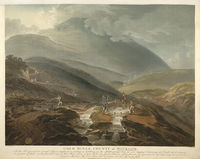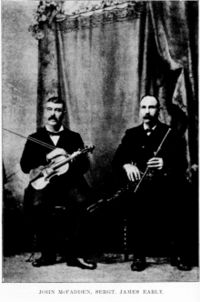Annotation:Miners of Wicklow (The)
Back to Miners of Wicklow (The)
MINERS OF WICKLOW, THE ("Na Tocalaide Ua Cill-Mantain" or "Mianairea Cille Meanntain"). AKA and see "Lassie of Gowrie (The)," "Paddy O'Flynn," "Wicklow's March (The)," "Nolan the Soldier." Irish, Double Jig. D Major (O'Neill, Huntingdon): F Major (Bunting). Standard tuning (fiddle). AA'BB'. Bunting includes the tune as an air in his third volume, The Ancient Music of Ireland (1840), but it was first published in Glasgow by James Aird, in his first volume of Selection of Scotch, English, Irish and Foreign Airs (1782).

The Wicklow Mountains are granite formations formed by the collision of continental plates. As the rock cooled cracks formed, which were filled with mineral dense hot fluids, that eventually formed veins of metal ore. Lead and zinc were the most common ores to be mined, although silver was also extracted. Mines in the Glendalough area date to the 1790's, and soon after Irish Rebellion of 1798 the 1798 a rich vein of lead ore in the Glendasan valley. Aird's publication predates these enterprises, however, so there was obviously mining activity in the Wicklow Mountains prior to this, and in fact, metals have been extracted from the Wicklows since the Bronze age, when copper was the primary ore sought. Lead mines came to the Vale of Avoca in the 1750's [1], and it is perhaps these that the title refers to.

Source for notated version: the playing partners of Chicago police Sergeant James Early and John McFadden, a piper and fiddler from adjoining counties in the province of Connaght [O'Neill]; the Irish collector Edward Bunting obtained the melody from "Macdonnell, piper in 1797."
Printed sources: Aird (Selection of Scotch, English and Irish Airs, vol. 1), 1782; No. 23, p. 9. Feldman, p. 231 (2nd tune, untitled). Bunting (Ancient Music of Ireland), 1840; p. 76. Holden (Old Established...), p. 6. Hughes (Gems from the Emerald Isles), London, 1867, No. 1, p. 2. Huntingdon (William Littens), 1977; p. 29. Levey (Dance Music of Ireland), volume I, 1840; p. 10. McGown (Repository of Scots and Irish Airs), c. 1800. O'Neill (Krassen), 1976; p. 50. O'Neill (Music of Ireland: 1850 Melodies), 1903; No. 995, p. 185. O'Neill (Dance Music of Ireland: 1001 Gems), 1986; No. 210, p. 49. O'Sullivan/Bunting, 1983; No. 102, pp. 148-149. Robbins, 1933; p. 56.
Recorded sources:
